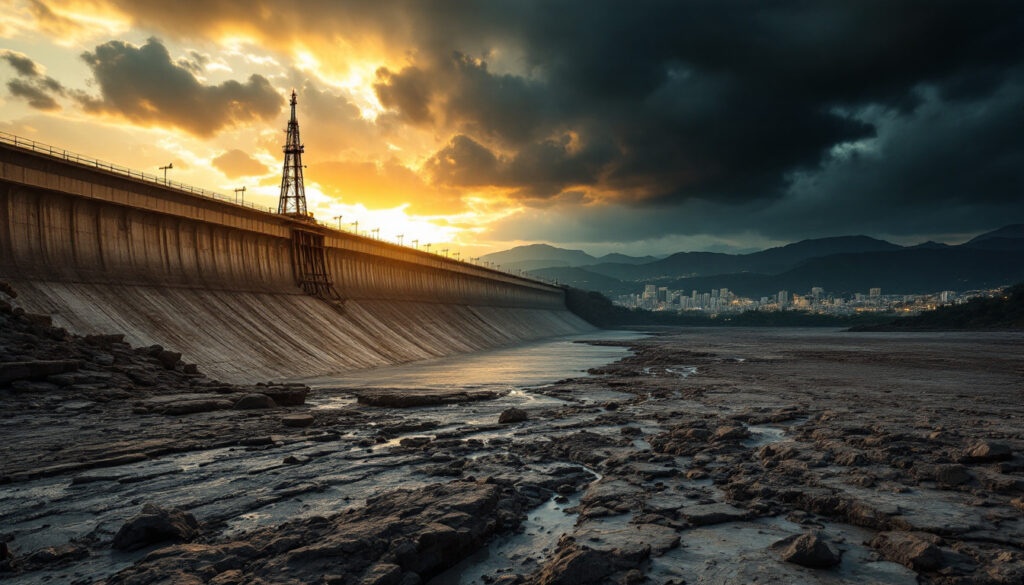Why is Venezuela Facing a Power Crisis?
Venezuela is currently grappling with an unprecedented power crisis that has pushed the country's infrastructure to breaking point. The situation stems primarily from the severe decline in hydroelectric generation capacity, which traditionally accounts for approximately 60% of Venezuela's electricity supply. According to recent data from Reuters (2025), hydroelectric output has plummeted by 40% since 2020 due to a combination of prolonged drought conditions and critical infrastructure decay.
The crisis is further compounded by the country's inability to provide sufficient fuel to thermoelectric plants, which now operate at a mere 15% of their capacity. This dangerous combination has created a perfect storm in Venezuela's energy sector, leading to increasingly lengthy power cuts across various regions.
Energy analyst Luis Oliveros provides critical insight into the situation: "The collapse of the Guri Dam's output is irreversible without foreign investment in turbine modernization. Years of deferred maintenance have created structural problems that can't be solved with short-term fixes."
The power cuts have become increasingly severe, with some regions experiencing blackouts averaging 12 hours daily. The states of Zulia and Carabobo have been particularly hard hit, with local infrastructure struggling to maintain even basic services. In March 2025, a major blackout in Caracas halted subway systems for 48 hours, affecting over 2 million commuters and bringing the capital to a standstill.
One often overlooked factor in Venezuela's power crisis is the country's aging transmission infrastructure. The national grid relies on transmission lines that are up to 70 years old, resulting in energy losses of approximately 30% during distribution. This technical limitation means that even when power is generated, significant portions never reach end users.
The Maduro administration has been forced to acknowledge the severity of the situation, announcing a 50% reduction in government office hours as an emergency measure to conserve electricity. This unprecedented step highlights the gravity of the crisis and suggests that the government has few immediate solutions at its disposal.
Hospitals in Maracaibo now rely almost entirely on diesel generators, consuming 200% more fuel than pre-crisis levels. This dependency creates a dangerous vulnerability in the healthcare system, where power interruptions can have life-threatening consequences.
How is PDVSA Responding to the Energy Emergency?
PDVSA (Petróleos de Venezuela, S.A.), the state-owned oil and gas company, has implemented a partial work-from-home policy as its primary response to the energy emergency. According to an internal document released on March 28, 2025, administrative staff—representing approximately 35% of PDVSA's 50,000 employees—will now work from offices only three days per week.
The policy mandates remote work for the remaining workdays, creating a hybrid model designed to significantly reduce the company's energy consumption. PDVSA estimates this measure will reduce energy usage at its Caracas headquarters by approximately 25%, based on consumption data from previous years.
PDVSA CEO Pedro Tellechea explained the rationale behind the decision: "Remote work ensures operational continuity while prioritizing fuel for core sectors. Our administrative facilities consume disproportionate energy compared to their contribution to production outputs."
This isn't PDVSA's first experiment with remote work as an energy-saving measure. A 2022 work-from-home pilot program saved an estimated 15,000 barrels of diesel monthly—a significant amount given the country's fuel scarcity issues. The company is building on this experience to implement the current, more comprehensive approach.
Energy Minister Néstor Reverol has indicated that similar measures may expand to other state-owned utilities: "What we're seeing at PDVSA could become a model for CORPOELEC and other energy-intensive state entities. The national emergency requires coordinated responses across all sectors."
An often-overlooked aspect of this policy is its cost-effectiveness beyond energy savings. PDVSA's Colombian subsidiary Citgo adopted similar hybrid workflows in 2023, cutting operational costs by an estimated $12 million annually through reduced facility maintenance and support services.
Administrative offices consume approximately 18% of PDVSA's total energy budget, a disproportionate amount compared to the 4% consumed by offshore rigs that generate significant revenue. This disparity highlights the potential efficiency gains from targeting non-essential energy consumption.
However, industry analysts have raised concerns about potential productivity impacts and cybersecurity risks associated with the remote work policy, especially given Venezuela's notoriously unreliable internet infrastructure. These concerns remain largely unaddressed in PDVSA's public communications about the initiative.
Which PDVSA Operations Will Continue Normally?
Despite the administrative adjustments, PDVSA has made it clear that critical operational areas will maintain normal operations throughout the energy crisis. Oil and gas production facilities will continue to function at current capacity, which stands at approximately 800,000 barrels per day (bpd)—a dramatic decrease from the 3 million bpd the country produced in 2010, according to OPEC's 2025 reports.
Refinery operations, though severely constrained compared to historical capacity, will continue without interruption. The Paraguaná Refining Complex, Venezuela's largest, currently operates at only 20% capacity but prioritizes diesel production for thermoelectric plants to mitigate the venezuela pdvsa power crisis. This strategic allocation highlights PDVSA's efforts to address the immediate energy emergency while maintaining essential operations.
Energy economist Francisco Monaldi notes: "PDVSA's survival hinges on shielding production from domestic crises. Any further disruption to output would create a death spiral for both the company and the national economy."
Trading activities and international business operations will also proceed without modification, ensuring that Venezuela maintains its vital foreign currency revenue streams. The protection of these revenue-generating activities reflects PDVSA's prioritization of financial stability amid the broader crisis.
From a technical perspective, maintaining continuous operations in the Orinoco Belt is particularly critical. The heavy crude extraction in this region requires 24/7 steam injection processes that demand uninterrupted power. Any disruption to these operations could damage reservoirs and require costly remediation efforts.
Union leader José Bodas has raised concerns about the human cost of maintaining operations: "Field workers face triple shifts to offset administrative cuts. The burden of keeping production flowing falls disproportionately on frontline staff already working in difficult conditions."
The Amuay refinery recently restarted its catalytic cracking units in February 2025 after securing $50 million in loans from Chinese partners. This development represents a rare bright spot in Venezuela's refining sector and underscores the importance of international relationships in maintaining critical infrastructure.
Interestingly, Chevron's joint ventures in Venezuela remain exempt from U.S. sanctions and continue producing approximately 200,000 bpd. This arrangement provides a stable operational model that contrasts sharply with PDVSA's struggling assets and offers a glimpse of what international cooperation could achieve in Venezuela's oil sector.
What is the Historical Context of Venezuela's Energy Problems?
Venezuela's current energy crisis represents the culmination of long-standing infrastructure problems rather than a sudden development. Over the past decade, investment in the national grid has collapsed precipitously, with data from the IMF (2024) indicating a 90% reduction in infrastructure spending between 2010 and 2020.
This chronic underinvestment has created a fragile system prone to catastrophic failure. The 2019 nationwide blackout lasted an unprecedented seven days and cost the economy an estimated $1.5 billion in GDP losses, according to the Economic Commission for Latin America and the Caribbean (ECLAC). This event foreshadowed the current crisis and demonstrated the system's extreme vulnerability.
Historian Miguel Tinker Salas provides important historical context: "Chávez's nationalization policies deterred private sector grid upgrades and created an environment where political loyalty often trumped technical expertise in infrastructure management." This perspective highlights how political dynamics created long-term consequences for Venezuela's energy infrastructure.
The technical deterioration at key facilities like the Guri Dam illustrates the impact of deferred maintenance. Delayed upkeep has caused turbine failures that reduced the dam's output from 10 gigawatts to approximately 6 gigawatts—a 40% reduction in capacity at Venezuela's most important power generation facility.
Former PDVSA director Rafael Ramírez has made explosive claims about the role of corruption in Venezuela's infrastructure decay: "Between 2004 and 2014, corruption diverted an estimated $300 billion from infrastructure projects, crippling the country's ability to maintain basic services." While these allegations remain contested, they point to governance issues that have exacerbated technical problems.
The 2016 drought offers another historical parallel to the current situation. That crisis forced the government to implement 4-hour daily blackouts nationwide, sparking protests that resulted in 15 deaths. The recurrence of similar problems suggests that Venezuela has failed to implement effective long-term solutions despite repeated crises.
A lesser-known aspect of Venezuela's energy challenges involves the role of imported diesel. In 2021, diesel imports from Iran cost approximately $120 million monthly amid hyperinflation, creating an unsustainable financial burden that diverted resources from infrastructure investment.
These recurring episodes of severe fuel scarcity and power crises have contributed significantly to Venezuela's broader economic challenges, creating a negative feedback loop where economic deterioration further limits the country's ability to address infrastructure needs.
How Might U.S. Sanctions Impact Venezuela's Energy Situation?
The United States imposed secondary tariffs on importers of Venezuelan oil this week, targeting approximately 500,000 barrels per day (bpd) of exports according to U.S. Treasury Department figures from 2025. This development represents a significant escalation in pressure on Venezuela's energy sector and could further complicate the country's ability to address its internal power crisis.
Perhaps more critically, the sanctions exemption for Chevron's operations in Venezuela is set to expire on April 18, 2025. This expiration puts at risk roughly 40% of the country's current oil output, potentially triggering a sharp decline in production capacity and associated revenues.
The U.S. State Department has been explicit about the political motivations behind these measures: "Sanctions aim to pressure Maduro into implementing genuine electoral reforms ahead of scheduled elections." This statement underscores the geopolitical context of Venezuela's energy challenges.
In response, China's Foreign Ministry has criticized the approach: "We oppose unilateral coercive measures harming developing nations. Energy security should not be weaponized for political objectives." This position reflects the international divide over how to address Venezuela's political and economic challenges.
From a technical perspective, sanctions have created significant obstacles to infrastructure maintenance and modernization. U.S. restrictions block Venezuela's access to Siemens turbines necessary for Guri Dam repairs, directly impacting the country's ability to restore hydroelectric capacity.
Venezuela has responded to sanctions by developing alternative export mechanisms, including a "shadow fleet" of approximately 115 tankers that operate outside international monitoring systems to bypass oil embargoes. This adaptation demonstrates the country's determination to maintain oil exports despite increasing international pressure.
The impact of sanctions extends to international business relationships. India's Reliance Industries halted Venezuelan oil imports in March 2025, shifting to Saudi Arabian crude sources instead. This realignment illustrates how secondary sanctions can reshape global commodity markets and further isolate Venezuela's oil industry.
A 2024 temporary sanctions waiver generated approximately $2.1 billion for PDVSA, but 70% of these funds were directed toward repaying debts to Russian oil company Rosneft rather than addressing domestic infrastructure needs. This allocation pattern highlights how external financial obligations continue to limit Venezuela's ability to invest in domestic energy solutions.
The combined effect of internal infrastructure problems and external pressures creates an extraordinarily challenging environment for Venezuela's energy sector, with limited options for near-term improvement.
What are the Broader Implications for Venezuela's Economy?
The venezuela pdvsa power crisis has profound implications for Venezuela's already struggling economy. According to the Venezuelan Chamber of Commerce (2025), power shortages cost the manufacturing sector approximately $3 billion annually in lost production, damaged equipment, and mitigation expenses.
The broader economic picture remains bleak, with GDP contracting by 8% in 2024 and inflation running at approximately 450%, according to Venezuela's Central Bank (BCV). These macroeconomic conditions severely limit the government's ability to invest in energy infrastructure solutions.
Economist Tamara Herrera provides a sobering assessment: "Every hour without power wipes out approximately 0.1% of annual industrial output. The cumulative effect is devastating for a country already facing severe economic contraction." This metric illustrates the direct relationship between energy reliability and economic performance.
The impact on small businesses has been particularly severe. Small business owner Carla Martínez notes: "Generators now consume 40% of my profits. Without reliable grid power, most small enterprises simply cannot remain viable." This testimony highlights how energy insecurity disproportionately affects smaller economic actors with limited resources for mitigation.
Currency devaluation has exacerbated the situation, with the exchange rate reaching 35 bolivars to the U.S. dollar in 2025. This devaluation has increased the cost of imported generators and spare parts by approximately 300%, making energy alternatives prohibitively expensive for many businesses and households.
Major employers have been forced to reduce operations dramatically. Polar Brewery, Venezuela's largest private employer, idled three plants in 2024, resulting in approximately 2,000 layoffs. These closures reflect how energy shortages directly translate to job losses and reduced economic activity.
An overlooked consequence of the crisis involves cross-border effects. Colombian border towns have seen a surge in black market activity, profiting from smuggled Venezuelan diesel that remains heavily subsidized despite the shortages. This illicit trade further depletes Venezuela's limited fuel resources.
Energy shortages also affect PDVSA's administrative capacity, potentially slowing critical decision-making processes within the oil industry. This administrative disruption creates second-order effects that can further hamper economic recovery efforts.
The situation ultimately highlights Venezuela's profound infrastructure vulnerabilities despite the country possessing the world's largest proven oil reserves—a paradox that underscores the complex relationship between resource wealth and effective governance.
FAQ: Venezuela's Power Crisis and PDVSA
What caused Venezuela's current power crisis?
Venezuela's power crisis stems from reduced hydroelectric generation at the Guri Dam (down 40% since 2020) and insufficient fuel for thermoelectric plants, which operate at just 15% capacity. Long-term underinvestment in grid infrastructure, with national grid spending falling 90% between 2010-2020, has created a system vulnerable to failure.
How has the government responded to the crisis?
The Maduro administration has implemented several emergency measures, including cutting government office hours by 50% and requiring PDVSA's administrative staff (35% of its workforce) to work remotely two days weekly. These measures aim to reduce consumption by an estimated 25% at major government facilities.
Will PDVSA's oil production be affected by these measures?
No, PDVSA has confirmed that operational areas including oil and gas production, refineries, and trading activities will continue normally. Current production stands at approximately 800,000 bpd, with critical operations like the Orinoco Belt heavy crude extraction receiving priority for power resources to maintain 24/7 operations.
What is the relationship between U.S. sanctions and Venezuela's energy problems?
U.S. sanctions target approximately 500,000 bpd of Venezuelan oil exports and block access to critical equipment like Siemens turbines needed for Guri Dam repairs. The upcoming expiration of Chevron's sanctions exemption (April 18, 2025) threatens 40% of current production. While sanctions exacerbate existing challenges, Venezuela's energy infrastructure was already deteriorating due to underinvestment and mismanagement.
Has Venezuela faced similar energy crises before?
Yes, Venezuela has experienced recurring energy crises over recent decades. Notable episodes include the 2016 drought that forced nationwide 4-hour blackouts and the 2019 blackout that lasted seven days and cost $1.5 billion in GDP losses. The current crisis represents an escalation of these long-standing problems rather than a new phenomenon.
Future Outlook for Venezuela's Energy Sector
The immediate future for Venezuela's energy sector remains precarious. Energy experts estimate that approximately $20 billion would be required to modernize the national grid and restore generation capacity to adequate levels. However, current budget allocations for infrastructure amount to just $200 million according to PDVSA's 2025 financial disclosures—merely 1% of the required investment.
Renewable energy presents an untapped opportunity. Venezuela's Lara State receives solar radiation averaging 250W/m² daily—excellent conditions for solar power generation—but import restrictions and lack of technical expertise have prevented meaningful development in this sector.
The UN Development Program has noted: "Renewables could offset 30% of Venezuela's hydroelectric dependency by 2030 with appropriate investment and policy frameworks." This assessment suggests that diversification could significantly improve energy security if properly implemented.
International cooperation remains challenging but essential for recovery. A proposed $1.2 billion deal with Turkey's Karpowership for floating power generation ships has stalled since negotiations began in 2023, highlighting the difficulties in securing international partnerships amid ongoing political tensions.
Energy analyst Elisabeth Eljuri provides context on the investment environment: "Expropriated assets deter foreign investors despite vast oil reserves. Without legal certainty and transparent governance, even the most promising resource base struggles to attract capital." This perspective underscores how governance issues complicate technical solutions.
Some regional partnerships show modest promise. Argentine firms have submitted bids to repair the Paraguaná Refinery in exchange for discounted oil deliveries
Ready to Identify the Next Major Mineral Discovery?
Take advantage of Discovery Alert's proprietary Discovery IQ model, which provides real-time alerts on significant ASX mineral discoveries, turning complex data into actionable insights. Visit our discoveries page to learn why historic discoveries can generate substantial returns and begin your 30-day free trial today.




